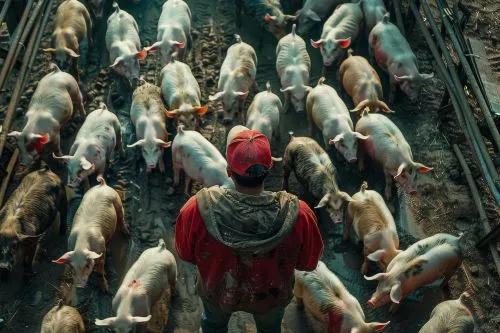
Efficient feeding of the herd is a key factor that affects the profitability of a dairy farm, regardless of the feeding system used. Maximizing homegrown feed production is essential, according to Dairy Australia.
Feed and Profit
Research from around the world, including Australia, has repeatedly demonstrated the link between higher levels of homegrown feed and greater profitability. This applies regardless of the feeding system or the level of farm intensity.
Dairy Australia emphasizes that in the vast majority of cases, homegrown feeds are cheaper than imported or purchased feeds. Therefore, it is essential for the sustainability of farming enterprises to maximize the production and utilization of this resource. Maximizing the production of native forages is crucial to improving the resilience and profitability of agricultural systems.
Dairy Australia has created an informational sheet outlining 5 common feeding systems on Australian dairy farms. While farms tend to become more intensive from system 1 to system 5, there is a misconception that homegrown feeds are less relevant in more intensive systems.
"This is incorrect," notes Dairy Australia, "as the most successful examples of system 5 – where cows are fully housed – still grow a significant proportion of their feed as homegrown feed, often as high-quality conserved forages such as maize silage or the like."
Highly Profitable Supplements
According to Dairy Australia, no system is considered better than others, and all systems can be profitable, and selecting the right system for your farm will largely depend on available resources and your attitude towards risk.
Homegrown feeds rarely fill all the feed gaps on Australian dairy farms, so supplements are used. These can be highly profitable if used correctly and efficiently.
Dairy Australia has also created an informational sheet on "Designing Balanced Diets for Milkers," which emphasizes how to maximize milk income minus feed costs in the herd and helps design high-quality diets for milkers that are nutritionally balanced.
It is important for farmers to calculate the daily nutrient requirements of cows, emphasizes Dairy Australia. Cows need diets that contain sufficient nutrients for maintenance, pregnancy, activity, growth, reproduction, and milk production. While water, energy, proteins, and fibers are key nutrients when formulating diets, minerals and vitamins should not be overlooked.
Dairy Australia advises dairy farmers to consider several factors when selecting feeds to use in milker diets: nutrient specifications, price, consistency of supply and quality, expected losses during storage (shrink), mixing and feeding, increased capital requirements for handling, additional labor requirements for handling, and other costs.
Income from milk minus feed costs
Feeds can vary significantly in their nutritional characteristics. Obtaining a feed testing analysis is the best way to determine the nutritional characteristics of a feed.
"High-quality feed is essential when designing diets for milking cows," explains Dairy Australia. "Defined by its percentage of neutral detergent fiber [NDF] and NDF digestibility values, feed quality has a substantial influence on feed intake. Feed quality determines the response to concentrates and diets."
Farmers should focus on 3 things when formulating a diet:
Percentage of feed NDF and NDF digestibility
Starch digestibility in the rumen
Percentage of protein and rumen degradability
Excessive nutrient supply can affect cow health, reduce feed conversion efficiency (kg of milk per kg of feed), and reduce income from milk minus feed cost, emphasizes Dairy Australia.
"On the other hand, underfeeding will impact performance and potentially cow health and fertility if severe. It may take several cycles to balance the major components of a diet and find a diet within the cow's appetite limit that provides the maximum possible income from milk minus feed cost."
Income from milk minus feed cost is a useful measure, especially in circumstances where pasture is limited or not available, says Dairy Australia. "It tells you how much of your milk income is left after paying for feed. This amount needs to cover operating costs such as herd, shed, labor, and overhead costs, plus financial and capital costs, including drawings."
Measuring Efficiency
Farmers who feed a significant amount of purchased feed need to achieve a high daily milk yield per cow to generate higher income from milk minus feed costs. The higher the milk production, the lower the percentage of non-productive expenses, meaning money spent more on cow maintenance rather than milk production and income.
Dairy Australia states that understanding the principles of marginal milk response versus average milk response is also essential when feeding supplements to maximize profit. Marginal milk response is the incremental increase in milk production obtained from an additional kilogram of feed supplement. Average milk response is the overall increase in milk production on average for all kilograms of feed supplement fed.
Feed Costs
Considering that feed costs represent a significant proportion of variable and total costs on a dairy farm, Dairy Australia emphasizes the importance of measuring the efficiency with which feeds are converted into milk.
Feed Conversion Efficiency (FCE) is a key measure of the feeding system's efficiency on a dairy farm, impacting the cost of feed per unit of milk and the operational profitability of milk.
FCE is also an important factor that affects the greenhouse gas emissions of a farm. "FCE should always be used in conjunction with other measures of physical and financial farm performance, such as annual milk operating profit and asset profitability," notes Dairy Australia.
FCE is expressed as the amount of milk produced per kilogram of feed given to the herd. FCE can be measured for the annual or seasonal milking herd each year. "FCE is a useful form of measurement to monitor the efficiency of a feeding program," says Dairy Australia.
"However, it should not be tightly associated with farm profitability as it does not take into account the cost of feed consumed by the herd. FCE is useful for evaluating the quality of feed consumed by the herd, particularly the forage component of the diet, as improved FCE is closely associated with higher-quality diets."
Key Feeding Points
- Create a steady monthly income from milk and a budget for feed to guide decisions.
- Purchase feeds based on quality and value.
- Efficiently convert feeds into milk, minimizing waste.
- Manage pastures according to best management practices. The three main objectives should be:
- Design and feed milking diets that generate the best possible return on investment.
- Protect the long-term productivity of the farm by maintaining good body condition and cow health.
- Protect the long-term productivity of pastures, allowing them to recover quickly when conditions eventually improve.




